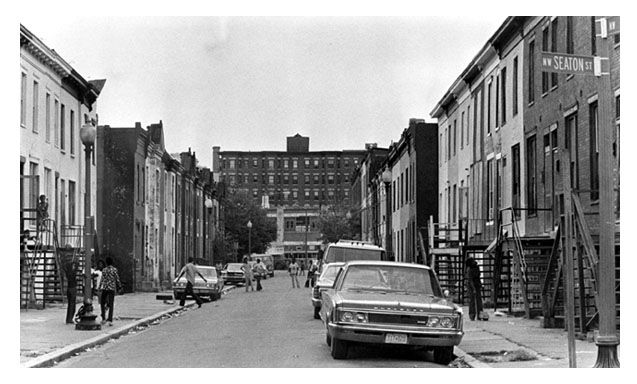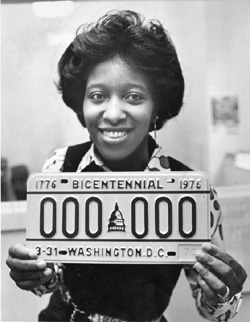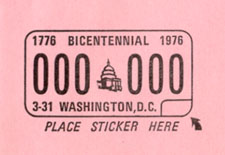1974 Bicentennial Baseplate
Issued April 1974 Through March 1978; Used Until c.Sept. 1986
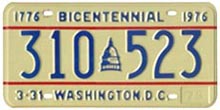 |
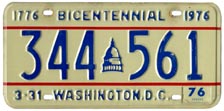 |
1974 (exp. 3-31-1975) |
1975 (exp. 3-31-1976) |
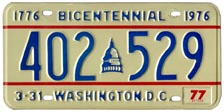 |
 |
1976 (exp. 3-31-1977) |
1977 (exp. 3-31-1978) |
Just the Facts... |
|
Construction |
6" x 12", aluminum covered with reflective white sheeting. Issued in pairs. |
Design |
Two red graphic horizontal stripes and an embossed image of the U.S. Capitol dome. |
Period of issuance |
Four years: April 1, 1974, through March 31, 1978. |
Period of use |
Twelve years and six months: April 1, 1974, through September 30, 1986. |
Non-passenger plates |
Examples of a number of types issued on the 1974 baseplate are pictured below. |
Other facts |
A registration year of April 1 through March 31 was used during the period that this base was issued. Plates that continued to be revalidated after the 1978 base was introduced were switched to the staggered system in early 1984. |
Plates of this base were assigned sequentially from number 100-001 through 499-999. After the first registration year, during which no validation sticker was used, reflective stickers were issued for subsequent years. With respect to plates distributed in conjunction with the issuance of a new registration (as opposed to a renewal transaction), the final three digits in the sticker serial number should match the final three digits on the plate. This concept is described in general at the Validation Stickers page, and specifically relative to the 1974 baseplate below.
There are two varieties of this base, both of which have "3-31" embossed in the lower left corner, indicating the annual March 31 expiration date, and a debossed sticker box in the lower right corner. The first style has "75" debossed in the sticker box. Plates of this style, the first to be issued, are numbered 100-000 through at least 336-171. The second style does not have the "75" year designation, and these are numbered from at least 340-359 through 499-999. The cutoff point between the dated and undated styles is believed to be plates numbered 340-000 and 340-001.
The Bicentennial Design
With its simple red horizontal stripes, the 1974 D.C. base is believed to be the second U.S. general-issue auto plate made with graphic reflective sheeting, however we're still uncertain whether the stripes on this particular base are actually part of the sheeting or were painted during the production process at Lorton, as we know they were on later plates. (The 1974 South Dakota plate was the first made with graphic sheeting, having been issued for use beginning in January of the year whereas the D.C. plate made its debut on April 1.) The design, with a U.S. Bicentennial theme slogan and simple embossed motif in the center, was likely created in response to Pennsylvania's similarly composed 1971 base. Of course, D.C. bested Pennsylvania by using a red, white, and blue color scheme, plus the commemorative 1776-1976 year designations.
 The 1974 baseplate design was introduced to the public on Dec. 19, 1972, with this photograph accompanying news reports on that day's D.C. City Council meeting at which it was approved. It had been unveiled to members of the council the previous day during its weekly executive session. “As is often the case when a new object d'art is unveiled,” reads the Star-News coverage of the Dec. 18 inspection by the council, “the reviews were mixed.” “I think it's delightful,” announced Councilman Rockwood H. Foster. “I think those red stripes are sort of symbolic of the red tape we have to cut through in Washington,” he said, ignoring the more obvious symbolism, the two stripes of the D.C. flag. Councilman Tedson J. Myers voted against the design, saying “Let's not be the first on the block to have a three-colored
license plate... let's come up with a plate that is functional, with larger numbers instead of pictures and advertising on it.” Little did the councilman know that the design would remain in use for decades and that after almost 30 years the numbers would be made smaller and more difficult to read. Councilwoman Marjorie H. Parker felt that the announced 1974 issuance date for the design was too far in advance of the 1976 bicentennial year. “It's like putting out your Christmas stocking in July,” she said.
The 1974 baseplate design was introduced to the public on Dec. 19, 1972, with this photograph accompanying news reports on that day's D.C. City Council meeting at which it was approved. It had been unveiled to members of the council the previous day during its weekly executive session. “As is often the case when a new object d'art is unveiled,” reads the Star-News coverage of the Dec. 18 inspection by the council, “the reviews were mixed.” “I think it's delightful,” announced Councilman Rockwood H. Foster. “I think those red stripes are sort of symbolic of the red tape we have to cut through in Washington,” he said, ignoring the more obvious symbolism, the two stripes of the D.C. flag. Councilman Tedson J. Myers voted against the design, saying “Let's not be the first on the block to have a three-colored
license plate... let's come up with a plate that is functional, with larger numbers instead of pictures and advertising on it.” Little did the councilman know that the design would remain in use for decades and that after almost 30 years the numbers would be made smaller and more difficult to read. Councilwoman Marjorie H. Parker felt that the announced 1974 issuance date for the design was too far in advance of the 1976 bicentennial year. “It's like putting out your Christmas stocking in July,” she said.
Clara Soumah of the D.C. DMV shows a sample of the 1974 baseplate shortly after it went on sale in early February. Courtesy DC Public Library, Star Collection, |
|
|
1974-78 Registration Numbers
As discussed below and with minor exceptions as indicated, we believe that certain blocks of registration numbers were used only for new general-issue passenger registrations during the four registration years during which this base was issued. The lowest numbers, 100-000 through about 285-000, are thought to have been available exclusively to replace valid 1968 baseplates during Mach 1974. Higher-numbered 1974 general-issue auto plates were issued during registration years specified in this table:
Reg. Year |
Twelve-Month Period of Use |
Sticker Marked |
General-Issue Registration Numbers |
Quantity of Available |
1974 |
4/1/74-3/31/75 |
n/a |
c.285-000 to 339-999 |
55,000 |
1975 |
4/1/75-3/31/76 |
"76" |
340-000 to 394-999 |
55,000 |
1976 |
4/1/76-3/31/77 |
"77" |
395-000 to c.447-999 |
53,000 |
1977 |
4/1/77-3/31/78 |
"78" |
450-000 to 499-999, then |
50,000 |
then c.448-000 to 449-999 |
2,000 |
1974 Baseplate Types
Only plate types of which we have found examples are pictured. Images of additional types will be added to the array below as they become available.
 |
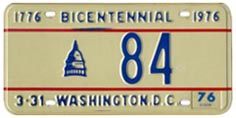 |
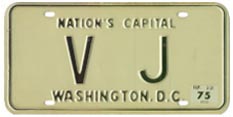 |
Passenger - General-Issue |
Pass. - Reserved Number |
Pass. - Personalized |
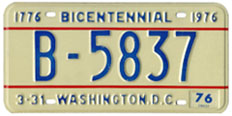 |
 |
 |
Bus |
Commercial (Truck) |
Dealer |
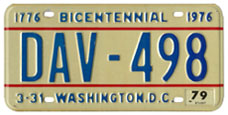 |
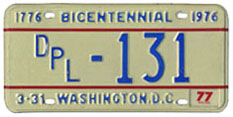 |
 |
Disabled American Veteran |
Diplomatic |
Diplomatic |
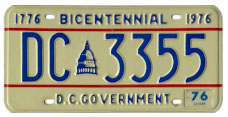 |
 |
 |
D.C. Government |
Hire (Taxi) |
Medical Doctor |
 |
||
Motorcycle |
||
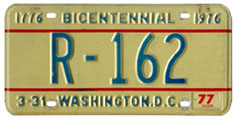 |
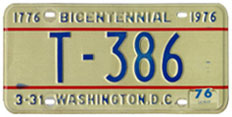 |
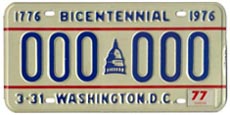 |
Rental |
Trailer |
Sample |
Correlation of 1974-77 General-Issue Registration Numbers to Sticker Serial Numbers
With respect to plates distributed in conjunction with the issuance of a new registration (as opposed to a renewal transaction), the final three digits in the sticker serial number should match the final three digits on the plate. In order to understand the discussion that follows, an understanding of the concept of a "natural" registration (and license plate) is required. Those unfamiliar with this term should consult the glossary as well as our page about validation stickers, upon the latter of which the subject is addressed in detail.
Stickers for 1975 (marked "76") through 1977 ("78") were issued for both renewal transactions and new registrations, whereas those of 1978 ("79") and later years, through as late as SEP 86 as listed and discussed on the 1978 baseplate page, were used to validate 1974 baseplates through September 30, 1986, while 1978 and 1984 baseplates were being issued for new registrations.
As discussed below, for the 1975, 1976, and 1977 registration years, those for which natural validation stickers were used on 1974 baseplates, it appears that sticker serial numbers began at 100000, 400000, and 700000, respectively. Approximately 55,000 new registrations appear to have been issued annually during the four-year period of issuance of this base.
1974 Registration Year (April 1974-March 1975) It is difficult to identify which registration numbers were assigned for new registrations (i.e. on natural 1974 plates) during the first year of issuance of this base because stickers were not issued to validate them. We assume that the highest-numbered plates before the lowest natural 1975 number, which we believe to be 340-000, were issued for new registrations during the 1974 registration year. Therefore, DCplates.net believes that any plate numbered from about 285-000 through 339-999 to which a "76" validation sticker was never affixed could reasonably be considered a natural 1974 plate.
1975 Registration Year (April 1975-March 1976) Natural license plates for this registration year are identifiable by the presence of a 1975 (marked "76") validation sticker with a serial number that corresponds to the registration number. The sticker serial on all observed natural 1975 plates is 240,000 digits lower than the plate number. Here are some examples:
License Plate Number |
1975 ("76") Sticker Serial No. |
340-359 |
100359 |
354-980 |
114980 |
388-906 |
148906 |
The lowest and highest plate numbers in the table above are the lowest and highest natural registration numbers observed for 1975. We believe that dated "76" stickers were applied to plates beginning at serial number 100000, which leads us to conclude that the first natural 1975 plate was number 340-000. Further information about 1975 stickers is provided here.
1976 Registration Year (April 1976-March 1977) Natural license plates for this registration year are identifiable by the presence of a 1976 (marked "77") validation sticker with a serial number that corresponds to the registration number. The sticker serial on all observed natural 1976 plates is 5,000 digits higher than the plate number. Here are some examples:
License Plate Number |
1976 ("77") Sticker Serial No. |
395-261 |
400261 |
428-942 |
433942 |
440-737 |
445737 |
The lowest and highest plate numbers in the table above are the lowest and highest natural registration numbers observed for 1976. We believe that dated "77" stickers were applied to plates beginning at serial number 400000, which leads us to conclude that the first natural 1976 plate was number 395-000. Further information about 1976 stickers is provided here.
1977 Registration Year (April 1977-March 1978) Natural license plates for this registration year are identifiable by the presence of a 1977 (marked "78") validation sticker with a serial number that corresponds to the registration number. The sticker serial number on all observed natural 1977 plates is 250,000 digits higher than the plate number. Here are some examples:
License Plate Number |
1977 ("78") Sticker Serial No. |
450-163 |
700163 |
455-427 |
705427 |
468-056 |
718056 |
The lowest and highest plate numbers in the table above are the lowest and highest natural registration numbers observed for 1977. We believe that dated "78" stickers were applied to plates beginning at serial number 700000, which leads us to conclude that the first natural 1977 plate was number 450-000. However, we have also seen plate no. 448-086 with a "78" sticker with serial 743086 over an earlier (presumably a "77") sticker, which we assume is a "two-sticker natural" as defined and discussed here using the 1968 base as an example. This plate, and others with similar numbers just below 450-000, were likely taken from leftover/unissued 1976 registration year stock and issued after plate 499-999 was assigned rather than go above 500-000, which by the time more 1977 numbers were needed had already been made on the forthcoming 1978 baseplate. Further information about 1977 stickers is provided here.
Reserved Registration Numbers Assigned Annually from April 1974 Through March 1978
Registrations 1 through 1250 were reassigned annually during this period. Click here to reach the section of our Reserved Number Plates page where serial numbers of stickers affixed to these plates are addressed.
|
This page last updated on December 31, 2017 |
 |
|
copyright 2006-2018 Eastern Seaboard Press Information and images on this Web site may not be copied or reproduced in any manner without consent of the owner. For information, send an e-mail to admin@DCplates.net |














